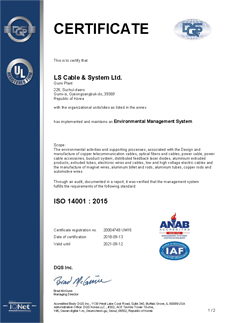Environmental Management
We will proactively respond to environmental risks by reducing environmental impacts throughout the product lifecycle through eco-friendly cable production and business site operation.
- Environmental management system
- Responding to climate change
- Environmental management system
Environmental management system
To build an environmental management system and meet the basic requirements of international standards, we are efficiently managing activities like compliance with environmental laws, environmental performance management, and reduction of environmental pollution.
- Scope of certification
- All production sites (Gumi, Indong and Donghae)
- Certification work
- Environmental management system for all operations related to the design, distribution and use of transmission and distribution cables (Gumi), telecommunication and industrial cables (Indong), and submarine and industrial specialty cables (Donghae)
- Effective period
- November 27, 2020 ~ September 12, 2021
- Certification authority
- DQS Inc.
* Its subsidiaries operate their own environmental management system certification.
- Domestic: : G&P, LS EV Korea and LS Alsco
- Overseas: LSCW, LS-VINA, LSCV, LSGM, LSCI, LSEVP, LSCP, LSMC
Responding to climate change
Introduction of renewable electrical energy
- 50% of power consumption at the Donghae and Indong plants will be provided by renewable energy.
Participation in the climate change network
- CDP Climate Change response (every year)
- Disclosing of greenhouse gas emissions and climate change response performance
Greenhouse gas emissions management
- Managing the use of energy highly associated with greenhouse gas emissions as a direct and indirect energy source
- Regular monitoring of usage
Environmental management system
Management of wastes
- Development of XLPE recycling technology
- Minimization of wastes generated through continuous process improvement and capital investment
- Continual efforts to increase the waste recycling rate
- Reduction of wastes through process improvement, capital investment, etc
Management of hazardous chemicals
- Introduction of a new hazardous chemicals monitoring system within the HSE system
- Build-out of an emergency system to respond to various chemical accidents
Management of air pollutants
- Atmospheric measurement and analysis of raw materials and processes: Monitoring of new pollutants
- 2Operation of equipment for reducing nitrogen oxide which accounts for 90% of air pollutants: Regenerative thermal oxidizers and selective catalytic reduction systems
Management of water pollutants
- Applying stricter criteria than legal acceptance criteria
- Managing effluent pollution level of 2020 within 10% of acceptance criteria
